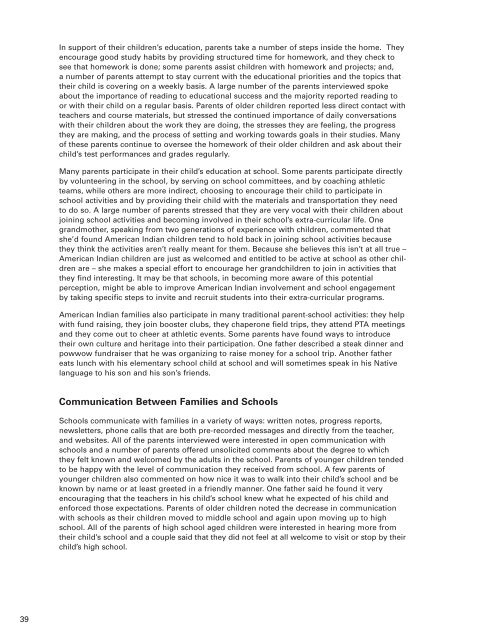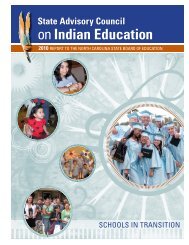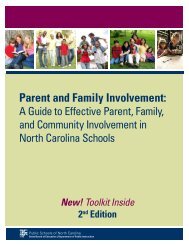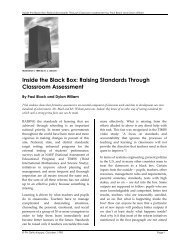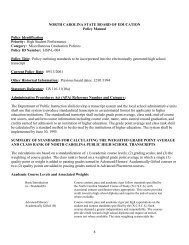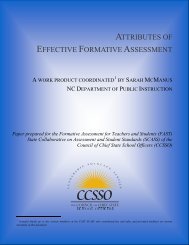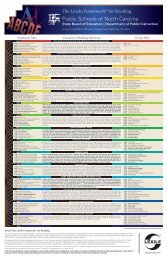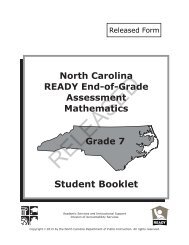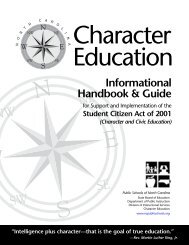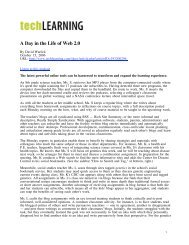pdf, 2.0mb - Public Schools of North Carolina
pdf, 2.0mb - Public Schools of North Carolina
pdf, 2.0mb - Public Schools of North Carolina
Create successful ePaper yourself
Turn your PDF publications into a flip-book with our unique Google optimized e-Paper software.
In support <strong>of</strong> their children’s education, parents take a number <strong>of</strong> steps inside the home. They<br />
encourage good study habits by providing structured time for homework, and they check to<br />
see that homework is done; some parents assist children with homework and projects; and,<br />
a number <strong>of</strong> parents attempt to stay current with the educational priorities and the topics that<br />
their child is covering on a weekly basis. A large number <strong>of</strong> the parents interviewed spoke<br />
about the importance <strong>of</strong> reading to educational success and the majority reported reading to<br />
or with their child on a regular basis. Parents <strong>of</strong> older children reported less direct contact with<br />
teachers and course materials, but stressed the continued importance <strong>of</strong> daily conversations<br />
with their children about the work they are doing, the stresses they are feeling, the progress<br />
they are making, and the process <strong>of</strong> setting and working towards goals in their studies. Many<br />
<strong>of</strong> these parents continue to oversee the homework <strong>of</strong> their older children and ask about their<br />
child’s test performances and grades regularly.<br />
Many parents participate in their child’s education at school. Some parents participate directly<br />
by volunteering in the school, by serving on school committees, and by coaching athletic<br />
teams, while others are more indirect, choosing to encourage their child to participate in<br />
school activities and by providing their child with the materials and transportation they need<br />
to do so. A large number <strong>of</strong> parents stressed that they are very vocal with their children about<br />
joining school activities and becoming involved in their school’s extra-curricular life. One<br />
grandmother, speaking from two generations <strong>of</strong> experience with children, commented that<br />
she’d found American Indian children tend to hold back in joining school activities because<br />
they think the activities aren’t really meant for them. Because she believes this isn’t at all true –<br />
American Indian children are just as welcomed and entitled to be active at school as other children<br />
are – she makes a special effort to encourage her grandchildren to join in activities that<br />
they find interesting. It may be that schools, in becoming more aware <strong>of</strong> this potential<br />
perception, might be able to improve American Indian involvement and school engagement<br />
by taking specific steps to invite and recruit students into their extra-curricular programs.<br />
American Indian families also participate in many traditional parent-school activities: they help<br />
with fund raising, they join booster clubs, they chaperone field trips, they attend PTA meetings<br />
and they come out to cheer at athletic events. Some parents have found ways to introduce<br />
their own culture and heritage into their participation. One father described a steak dinner and<br />
powwow fundraiser that he was organizing to raise money for a school trip. Another father<br />
eats lunch with his elementary school child at school and will sometimes speak in his Native<br />
language to his son and his son’s friends.<br />
Communication Between Families and <strong>Schools</strong><br />
<strong>Schools</strong> communicate with families in a variety <strong>of</strong> ways: written notes, progress reports,<br />
newsletters, phone calls that are both pre-recorded messages and directly from the teacher,<br />
and websites. All <strong>of</strong> the parents interviewed were interested in open communication with<br />
schools and a number <strong>of</strong> parents <strong>of</strong>fered unsolicited comments about the degree to which<br />
they felt known and welcomed by the adults in the school. Parents <strong>of</strong> younger children tended<br />
to be happy with the level <strong>of</strong> communication they received from school. A few parents <strong>of</strong><br />
younger children also commented on how nice it was to walk into their child’s school and be<br />
known by name or at least greeted in a friendly manner. One father said he found it very<br />
encouraging that the teachers in his child’s school knew what he expected <strong>of</strong> his child and<br />
enforced those expectations. Parents <strong>of</strong> older children noted the decrease in communication<br />
with schools as their children moved to middle school and again upon moving up to high<br />
school. All <strong>of</strong> the parents <strong>of</strong> high school aged children were interested in hearing more from<br />
their child’s school and a couple said that they did not feel at all welcome to visit or stop by their<br />
child’s high school.<br />
39


